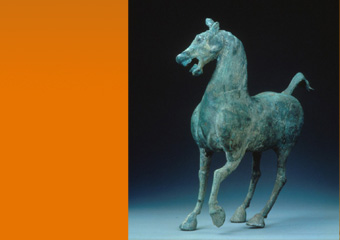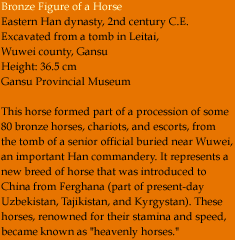 |
|
 |

 Horses are the foundation of military might, the great resource of the state — Ma Yuan, first century B.C.E. Although foreign influences had penetrated China since early times, official interest in the west began only during the Han dynasty (206 B.C.E.–220 C.E.). Threatened by incursions of mounted nomadic tribes from the north and northwest, the Han emperor Wudi (r. 141–87 BCE) dispatched missions westwards to seek allies. Although these missions were unsuccessful in securing alliances, they returned with reports, not only of an existing trade in Chinese products, but also of a superior breed of horses. It was in part the need to secure this breed of horse, vital to the Han campaigns against the nomads, that drove Han armies into Central Asia. By the late second century B.C.E., military colonies were established in Gansu to protect the trade routes from nomadic incursions. These colonies became important trading posts on the Silk Road. The main route led from Chang'an (modern Xi'an) through Lanzhou, Wuwei, Zhangye, Jiuquan to Dunhuang and was protected by a Han extension to the Great Wall. As trade flourished, new products and ideas entered China, brought by foreign merchants. Buddhism entered China at this time, but was confined mainly to colonies of foreign merchants. Indeed, imperial control of the country ensured that foreign influences were still largely unassimilated or marginalized. With the fall of the Han in 220 C.E., this situation began to change. China fragmented into independent kingdoms, and non-Han ethnic groups began to gain ascendancy. In the early fourth century, the ancient capitals Luoyang and Chang�an were sacked by armies of former nomad mercenaries and Gansu and Ningxia came under the rule of a succession of short-lived kingdoms, some of nomad origin. The breakdown of imperial rule had important consequences. The new rulers did not look solely to the capitals for cultural models, but instead were open to influences from outside. Buddhism began to take root, creating a demand for scriptures and images. |
||||